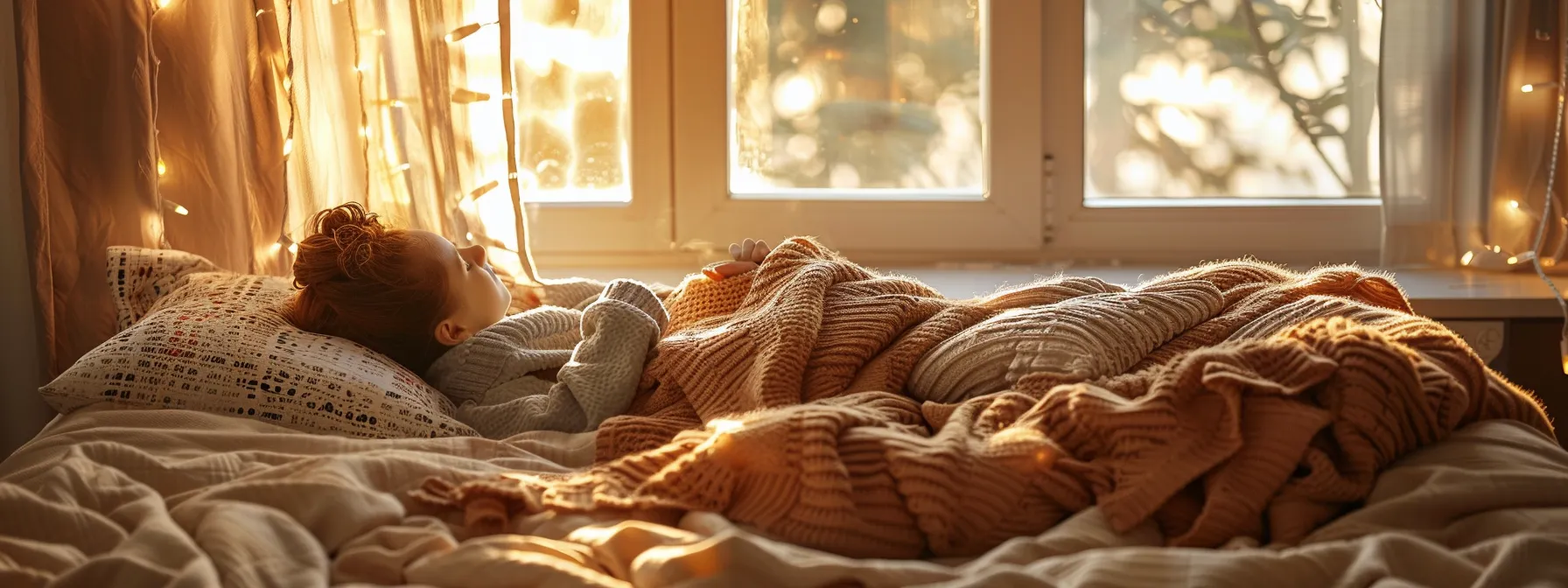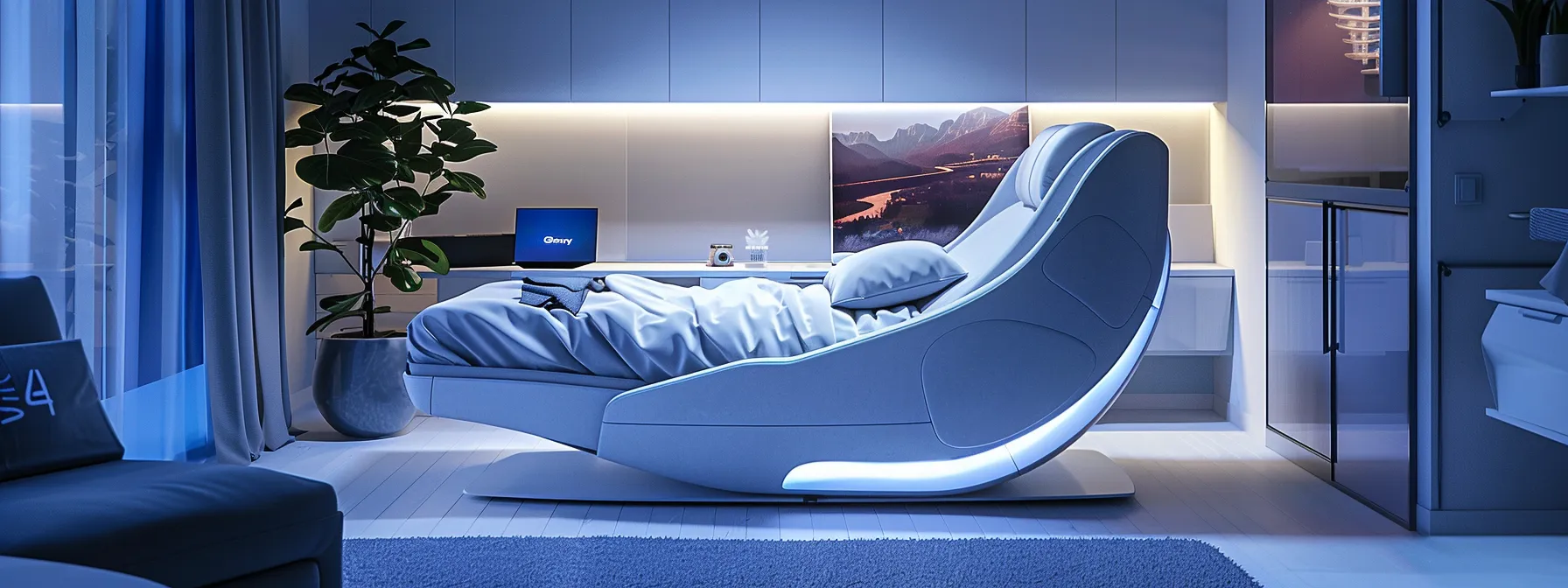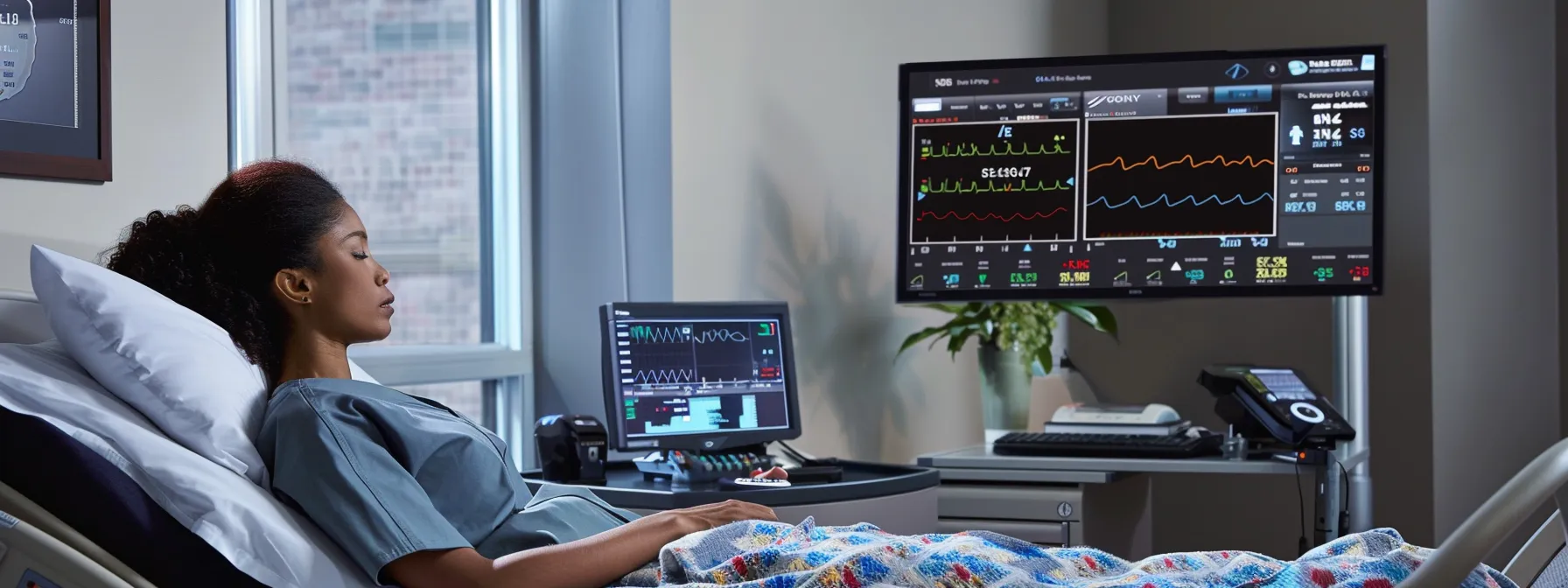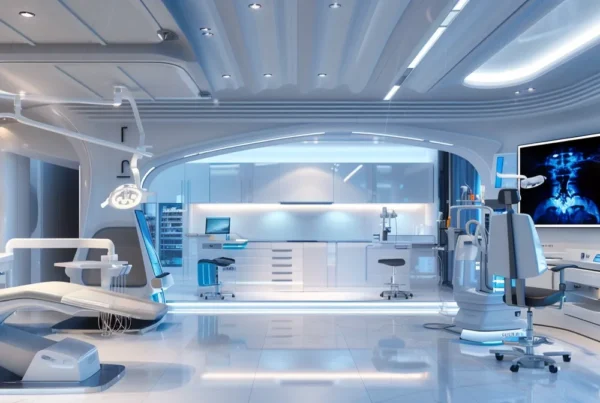Do you struggle with sleep apnea and wonder if there’s a simple solution? Positional therapy might be the answer. This article explores effective sleeping positions, sleep hygiene practices, and positional devices that can help alleviate sleep apnea symptoms. You’ll learn about lifestyle changes to support your therapy and how to monitor your progress. By understanding these techniques, you can take steps towards better sleep and improved overall health.
Key Takeaways
- Positional therapy offers non-invasive relief for sleep apnea by adjusting sleeping positions to improve breathing
- Side sleeping and elevated head positions can significantly reduce sleep apnea events and improve airflow
- Consistent sleep routines and a well-designed sleep environment contribute to better sleep quality for apnea patients
- Various positional devices, from simple wedge pillows to advanced electronic positioners, can help manage sleep apnea
- Regular physical activity, dietary choices, and weight management play crucial roles in supporting positional therapy effectiveness
Understand Positional Therapy for Sleep Apnea Treatment
Positional therapy offers relief for sleep apnea patients by adjusting sleeping positions to reduce snoring and improve breathing. This cpap alternative explores various techniques used in positional therapy, including technology-based solutions such as cpap vs oral appliances and home sleep modifications.
By addressing soft tissue obstructions in the mouth and throat, positional therapy provides numerous benefits for those seeking non-invasive sleep apnea treatment options, including kids sleep apnea treatment. To request appointment, contact Dr. Eugene Azuma today for comprehensive pediatric sleep apnea honolulu services.
Define Positional Therapy and Its Purpose in Sleep Apnea Care
Positional therapy is a non-invasive cpap alternative treatment approach for sleep apnea that focuses on adjusting a patient’s sleeping position to improve breathing and reduce symptoms. This method, as recommended by Dr. Eugene Azuma, aims to prevent the collapse of soft tissues in the throat, which can cause obstructions and lead to choking or parasomnia episodes during sleep. By encouraging patients to sleep on their side or in an elevated position, positional therapy can complement other treatments like weight loss or the use of a mandibular advancement splint.
Additionally, understanding cpap vs oral appliances can help in selecting the most suitable treatment. Sleep centers often recommend this approach as an initial step in managing sleep apnea, particularly for those who experience symptoms primarily when sleeping on their back. For families considering options, pediatric sleep apnea Honolulu offers various solutions, and kids sleep apnea treatment is also available to address pediatric needs. To get started, you can request appointment through our website.
Identify the Different Techniques Used in Positional Therapy
Positional therapy techniques for sleep apnea treatment include various methods to maintain optimal sleeping positions. These range from simple home remedies to advanced technology-based solutions. Some common approaches involve using special pillows or wedges to elevate the upper body, reducing pressure on the throat. Patients may also wear positional devices that encourage side sleeping, which can help keep the airway open.
In Honolulu, HI, dentists and physicians such as Dr. Azuma often recommend these techniques as part of a comprehensive pediatric sleep apnea management plan, including kids sleep apnea treatment. Patients should discuss cpap vs oral appliances and insurance coverage with their healthcare provider when considering a cpap alternative or request appointment:
Explore the Benefits of Positional Therapy for Sleep Apnea Patients
Positional therapy offers numerous benefits for sleep apnea patients. Research shows it can significantly reduce snoring and improve sleep quality. This accessible treatment option doesn’t require expensive equipment like CPAP machines or surgical interventions, addressing the cpap vs oral appliances discussion.
Patients often find positional therapy more comfortable than using a mouthguard, leading to better compliance. For those with mild to moderate sleep apnea, this approach can be a highly effective cpap alternative. Additionally, it is suitable for pediatric sleep apnea cases. To explore this further, you can request appointment with Dr Eugene Azuma for kids sleep apnea treatment.
Discover Effective Sleeping Positions for Better Sleep

Effective sleeping positions play a crucial role in managing sleep apnea and pediatric sleep apnea. This section explores optimal positions to reduce apnea events, compares side sleeping to back sleeping, and examines how body positioning affects airway obstruction. Dr. Eugene Azuma’s dental expertise, combined with insights from Delta Dental, offers practical solutions such as cpap alternative and cpap vs oral appliances to improve sleep quality and overall health. If you’re seeking kids sleep apnea treatment, you can request appointment with Dr. Eugene Azuma.
Analyze Optimal Sleeping Positions for Reducing Sleep Apnea Events
Optimal sleeping positions can significantly reduce sleep apnea events by improving airflow and oxygen levels. side sleeping, particularly on the left side, helps maintain an open airway and reduces the risk of obstruction.
For people with pediatric sleep apnea Honolulu concerns or those using clear aligners, elevating the head slightly can further enhance breathing during sleep. kids sleep apnea treatment can help address these issues effectively. Dr. Azuma (Dr. Eugene Azuma) recommends these positions as a cpap alternative to address sleep-related breathing disorders and promote overall health. To request appointment or explore cpap vs oral appliances, contact our clinic:
Assess the Impact of Side Sleeping Versus Back Sleeping
Side sleeping offers significant benefits for sleep apnea patients compared to back sleeping. Sleeping on one’s side helps keep the airway open, reducing breathing difficulties and improving overall sleep quality. Back sleeping often leads to more frequent apnea events due to the tongue and soft palate falling back into the throat.
Dr. Eugene Azuma recommends side sleeping as part of a comprehensive sleep health strategy, which may also include dental treatments, kids sleep apnea treatment, cpap alternative, and regular check-ups. Patients should discuss their sleeping positions with their healthcare provider or request appointment to ensure they’re getting the most effective treatment for their condition, such as cpap vs oral appliances and pediatric sleep apnea:
- Side sleeping reduces airway obstruction
- Back sleeping may increase apnea events
- Consult with a healthcare provider for personalized advice
- Consider dental treatments as part of sleep apnea management
Review How Body Positioning Affects Airway Obstruction
Body positioning significantly affects airway obstruction in sleep apnea patients. When lying on the back, gravity pulls the tongue and soft palate towards the throat, increasing the likelihood of snoring and breathing difficulties. side sleeping, especially with proper pillow support, can help maintain an open airway and reduce vibration-related noise.
In Hawaii, Dr. Eugene Azuma and other dental professionals often recommend positional therapy as a cpap alternative as part of a comprehensive snoring treatment plan for pediatric sleep apnea Honolulu patients. Patients interested in clinical trials for innovative cpap vs oral appliances sleep apnea solutions can request appointment via fax or during consultations. Effective body positioning techniques include kids sleep apnea treatment:
Term:
- Elevating the head with an adjustable bed or wedge pillow
- Using body pillows to maintain side sleeping position
- Incorporating positional alarms to alert patients when they roll onto their back
- Practicing sleep hygiene techniques to improve overall sleep quality
Comprehend the Importance of Sleep Hygiene Practices
Good sleep hygiene practices play a crucial role in managing sleep apnea. This section explores how consistent sleep routines, environmental factors, and relaxation techniques contribute to better sleep quality. Understanding these elements can complement other treatments like weight management, CPAP, or oral appliances, offering a cpap vs oral appliances perspective.
Incorporating cpap alternatives can provide more personalized solutions for patients. Additionally, kids sleep apnea treatment can benefit from innovative approaches such as nightlase laser treatment or orthodontics to address muscle-related issues affecting sleep in pediatric sleep apnea cases. To explore specialized options, patients can request appointment with Dr. Eugene Azuma.
Implement Consistent Sleep Routines for Improved Sleep Quality
Implementing consistent sleep routines can significantly improve sleep quality for sleep apnea patients. Dental hygienists often recommend establishing a regular bedtime and wake-up schedule to help regulate the body’s internal clock. This routine, combined with positive airway pressure therapy, cpap alternative, cpap vs oral appliances, and kids sleep apnea treatment, can enhance the effectiveness of sleep apnea treatment.
For patients who experience anxiety about their condition, incorporating relaxation techniques or considering sedation options may be beneficial. Those interested in exploring neuroscience-based approaches or request appointment for personalized advice can contact Dr. Eugene Azuma’s office for pediatric sleep apnea:
Investigate How Environment Influences Sleep Apnea Management
The sleep environment plays a crucial role in managing sleep apnea. A well-designed bedroom can reduce sleep deprivation and improve overall sleep quality. Factors such as room temperature, lighting, and noise levels can significantly impact sleep patterns.
Patients visiting a dental office for sleep apnea treatment, including kids sleep apnea treatment and pediatric sleep apnea, should discuss environmental modifications with their provider. These changes, combined with proper dental care and treatments like dental implants or cpap vs oral appliances or cpap alternative, can help reduce the risk of tooth-related issues associated with sleep disorders. To get started, patients can request appointment with Dr. Eugene Azuma.
Discuss the Role of Relaxation Techniques in Promoting Restful Sleep
Relaxation techniques play a vital role in promoting restful sleep for pediatric sleep apnea patients. These practices can help reduce somnolence and prepare the body for better sleep quality. Dr. Eugene Azuma’s dental lab offers guidance on incorporating relaxation methods into nightly routines, which can complement other treatments like cpap vs oral appliances or Monday night sleep studies. For kids sleep apnea treatment, patients can request appointment to explore cpap alternatives. Effective relaxation techniques can lower blood pressure and reduce stress, contributing to improved overall health:
- Deep breathing exercises
- Progressive muscle relaxation
- Guided imagery
- Mindfulness meditation
- Gentle stretching before bed
Explore the Use of Positional Devices for Sleep Apnea Relief

Positional devices offer effective relief for sleep apnea patients, including those requiring kids sleep apnea treatment and pediatric sleep apnea, serving as a cpap alternative. This section explores various market options, evaluates the effectiveness of pillows and wedges, and compares different sleep aids such as cpap vs oral appliances designed for positional therapy.
Dental experts like Dr. Eugene Azuma recommend these devices to address issues related to the palate and reduce hypertension. To request appointment, polysomnography studies have shown promising results in improving sleep quality through positional therapy.
Highlight Various Positional Devices Available on the Market
Sleep apnea patients can find relief through various positional devices available on the market. These medical aids, which can serve as a cpap alternative, are designed to promote optimal sleeping positions, ranging from simple wedge pillows to advanced electronic positioners. Dr. Eugene Azuma may recommend these devices as part of a comprehensive treatment plan, which could also include pediatric sleep apnea Honolulu, kids sleep apnea treatment, and laser therapy for snoring reduction.
Patients can request appointment and schedule consultations with sleep specialists to discuss the most suitable options for their needs, including cpap vs oral appliances. Some devices even incorporate smart technology to track sleep patterns and adjust positioning throughout the night, offering personalized care for those struggling with sleep-disordered breathing.
Evaluate the Effectiveness of Positional Pillows and Wedges
Positional pillows and wedges have shown promising results in managing sleep apnea symptoms, particularly as a cpap alternative for patients with nasal congestion or malocclusion issues. These devices help maintain proper alignment of the mandible and surrounding tissue, reducing airway obstruction during sleep.
Studies conducted at pediatric sleep apnea honolulu centers in Honolulu have demonstrated that specially designed pillows can significantly decrease the frequency of apnea events, especially in children with underdeveloped facial structures, making them an effective kids sleep apnea treatment. Additionally, understanding cpap vs oral appliances can help in selecting the appropriate therapy. For more information or to request appointment, contact Dr. Eugene Azuma.
Compare Different Types of Sleep Aids Designed for Positional Therapy
Sleep aids designed for positional therapy offer various options for patients seeking relief from sleep apnea. From simple wedge pillows to advanced electronic devices, including cpap alternative and cpap vs oral appliances, these aids help maintain optimal sleeping positions throughout the night.
Patients in Honolulu can request appointment with Dr. Eugene Azuma to discuss which option best suits their needs, especially if they experience insomnia, alcohol-related sleep issues, or require kids sleep apnea treatment. Additionally, those seeking pediatric sleep apnea can consult with specialists to ensure effective care. Some devices even incorporate smart technology to track sleep patterns and adjust positioning, ensuring a better smile and improved overall health:
- Wedge pillows for elevated sleeping
- Body positioning pillows
- Vibrating positional alarms
- Smart wearable devices
- Adjustable beds with sleep tracking features
Learn About Lifestyle Changes to Support Positional Therapy
Lifestyle changes play a crucial role in supporting positional therapy for sleep apnea patients. This section explores how physical activity, dietary choices, and weight management strategies can improve sleep quality and reduce symptoms.
By addressing issues like fatigue and restless legs syndrome, patients can enhance the effectiveness of their treatment, which may include prosthodontics, cpap alternative, or soft palate adjustments by Dr. Eugene Azuma. Patients can request appointment to discuss their options. These practical approaches complement the use of sleep masks and other therapies such as cpap vs oral appliances.
Incorporate Physical Activity Into Your Daily Routine for Better Sleep
Regular physical activity can significantly improve sleep quality for sleep apnea patients, serving as a cpap alternative. Engaging in exercises like brisk walking, swimming, or yoga can help reduce symptoms and enhance overall health. Patients visiting a sleep center for treatment may receive recommendations to request appointment with specialists like Dr. Eugene Azuma to incorporate moderate exercise into their daily routine. T
his approach complements other pediatric sleep apnea treatments, such as dental implants or dentures, and kids sleep apnea treatment, by promoting better airflow and reducing fatigue. Additionally, understanding cpap vs oral appliances can help patients choose the right treatment. Even simple activities like teeth cleaning can contribute to improved oral health and better sleep patterns.
Examine Dietary Choices That Can Influence Sleep Apnea Symptoms
Dietary choices significantly influence sleep apnea symptoms, as revealed by evaluations at medical centers. Patients can inspire better sleep by avoiding foods that exacerbate gum inflammation and opting for nutrient-rich options that support respiratory health. While rare, some individuals may experience sleepwalking episodes related to certain food triggers. A balanced diet tailored to sleep apnea management includes cpap alternative and may involve requesting appointment for specialized care.
Investigate Weight Management Strategies for Sleep Apnea Patients
Weight management plays a crucial role in managing sleep apnea symptoms for many patients. Honolulu dentists, such as Dr. Eugene Azuma, often recommend combining dietary changes with regular exercise to achieve and maintain a healthy weight. Patients who undergo cosmetic dentistry or receive sleep apnea oral appliances, a CPAP alternative, may find that weight loss enhances the effectiveness of their treatment.
By working with a healthcare team, including endodontists and sleep specialists, patients can develop personalized strategies to address both their oral health and sleep-related breathing issues. To get started, you can request appointment with our experts.
Monitor Your Progress and Adjust Therapy as Needed

Monitoring progress and adjusting therapy is crucial for effective sleep apnea management. This section explores tracking sleep patterns, utilizing sleep studies, and adapting positional therapy based on individual health changes. For both adults and kids, regular assessment and kids sleep apnea treatment help optimize treatment outcomes.
Understanding brain activity during sleep can provide valuable insights for patients and healthcare providers, ensuring the most effective approach to pediatric sleep and overall sleep health. If you need assistance, you can request appointment with Dr. Eugene Azuma.
Track Sleep Patterns to Understand Therapy Effectiveness
Tracking sleep patterns helps patients and polysomnographic technologists understand the effectiveness of positional therapy for sleep apnea. By monitoring factors like tongue and uvula position during sleep, Dr. Eugene Azuma and other neurologists can assess patient safety and adjust treatments accordingly, considering options such as cpap vs oral appliances. Regular sleep tracking provides valuable insights into how positional changes affect breathing, allowing for personalized therapy modifications that improve overall sleep quality and reduce apnea events. Patients seeking a cpap alternative may request appointment for further evaluation.
Utilize Sleep Studies to Assess Ongoing Sleep Apnea Issues
Sleep studies play a crucial role in assessing ongoing sleep apnea issues for patients undergoing positional therapy. These diagnostic tests help dentists and sleep specialists evaluate factors such as weight changes, blood pressure fluctuations, and recurring headaches that may impact treatment effectiveness.
By monitoring brain activity and breathing patterns during sleep, medical professionals can adjust therapy as needed, exploring CPAP alternatives or comparing CPAP vs oral appliances, ensuring optimal results for patients with various dental concerns, including those who have recently received a crown.
Adjust Positional Therapy Based on Individual Health Changes
Adjusting positional therapy based on individual health changes is crucial for managing sleep apnea symptoms effectively. Patients visiting clinics in Oahu should regularly consult with their family medicine providers and request appointment to assess the need for therapy modifications.
As weight, lifestyle, or overall health conditions change, sleep specialists at Hawaii Pacific Health, including Dr. Azuma, may recommend altering sleeping positions or incorporating new cpap alternative techniques to address evolving sleep apnea patterns.
Conclusion
Positional therapy offers a non-invasive, cost-effective approach to managing sleep apnea, providing relief through simple adjustments in sleeping positions. By implementing consistent sleep routines, optimizing the sleep environment, and utilizing positional devices, patients can significantly reduce apnea events and improve overall sleep quality.
Lifestyle changes, including regular physical activity, dietary modifications, and weight management, play a crucial role in enhancing the effectiveness of positional therapy. Regular monitoring and adjustment of therapy, in consultation with healthcare professionals, ensure that patients receive personalized care that adapts to their changing health needs, ultimately leading to better sleep and improved well-being.
Visit our website to learn more about our sleep apnea treatments. It’s time to move beyond feeling like just another patient. With Dr. Eugene Azuma, feel confident, informed, and thrilled about your smile and health!
Schedule your free consultation today and breathe better!
Dr Eugene Azuma DDS
1060 Young St # 220
Honolulu, HI 96814


